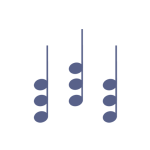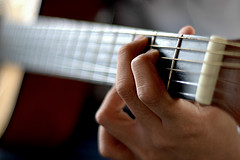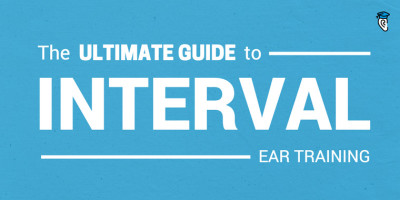Have you wondered how some guitarists seem to just know what notes to play? They can pick out a tune by ear, play along with a song they’ve only just heard and improvise killer solos without any need for sheet music, tab, or fretboard patterns.
How do they do it? The answer is that they have a well-trained musical ear, and by doing simple ear training exercises on guitar you can hone your own ears in the same way.
As a guitar player, ear training can help you to:
- Identify notes and chords by ear
- Play pitch bends with more accuracy
- Use audio effects (FX) properly to improve your sound
- Have a better sense of rhythm
- Play with more expression, wowing your listener
In this article we’ll look at one particular area of guitar ear training: interval recognition.
With so many areas of guitar ear training you could work on, why start with intervals?
How interval recognition can help you
An interval is simply the distance in pitch between two notes. Like this:
or this:
The different distances have different names and distinctive sounds. By learning to recognise the different pitch distances by ear you gain the ability to recognise notes and chords and play them by ear.
That means the next time you want to play a song and can’t find the tab – no problem! You can work it out yourself, by ear. You’re also freed up from dependence on sheet music, rote learning, and soloing purely from fretboard patterns. Finally you’ll understand what it’s like to really connect with your instrument and be able to bring out whatever music you hear in your head.
Five reasons for a guitarist to learn intervals
Here are five reasons that intervals are a great starting point for any guitarist who wants better ears:
1. Relative Pitch
 Your sense of relative pitch is what lets you identify notes you hear by ear.
Your sense of relative pitch is what lets you identify notes you hear by ear.
Intervals aren’t the only way to develop your relative pitch. Some guitarists choose to start with chord ear training instead, or use the solfa approach (scale degree ear training).
When you’re just starting out though, intervals are a great choice because they are the most basic “building blocks” for developing your sense of relative pitch. They are as simple as can be: just two notes.
You can usefully explore other approaches later on, but if you are beginning to develop your relative pitch, start opening up your ears using these basic building blocks first.
2. Fingering Fluency
Practicing intervals on guitar involves learning what they look like on each pair of strings across your fretboard. For example, here’s an exercise for practising playing different minor seconds:
As you practice listening to them you’re also practicing playing them, training your fingers for different combinations of notes and fast changes.
By combining the listening practice with the fingering practice through exercises like this you ensure that your interval skills are closely connected to your guitar skills. The intervals have a meaning and physical resonance with you that you would miss out on by simply listening to ear training exercises.
3. Pick Apart Patterns
After a little time spent practicing intervals on guitar you will start to see your usual fretboard patterns in a whole new light. That minor pentatonic scale or triad shape you’ve been using for years suddenly reveals its component intervals too so that you can understand it in detail and use it in new more creative ways.
4. Break Out
Patterns and rules are helpful for soloing, especially when you’re just getting started with guitar improvisation. However there is a danger of getting trapped in those patterns so that your solos start to sound robotic and predictable. Interval ear training can help you break out beyond those patterns and choose more interesting notes when improvising.
5. Firm Foundation
 Because intervals are the fundamental “building blocks” of relative pitch, learning to recognise intervals puts you in solid position to go further with ear training, learning to recognise chords and progressions by ear and unlocking the full fretboard to you in everything you play.
Because intervals are the fundamental “building blocks” of relative pitch, learning to recognise intervals puts you in solid position to go further with ear training, learning to recognise chords and progressions by ear and unlocking the full fretboard to you in everything you play.
How to start learning intervals on guitar
If one or more of those reasons resonated with you, you can get started today with these free resources:
Begin by learning all about intervals with our Ultimate Guide to Interval Ear Training:
Then get guidance on how to apply this on guitar specifically in this tutorial on interval ear training on guitar:

Guitar Interval Practice:
Learn to Recognize Intervals
If you have ever felt trapped in fretboard patterns and reliance on tab, then developing your sense of relative pitch will set you free.
Intervals are a great way to start building your relative pitch in an easy step-by-step way, and the resources above will set you on the right path for success with guitar interval ear training. Don’t be held back any longer – use intervals as your building blocks towards fretboard freedom!









